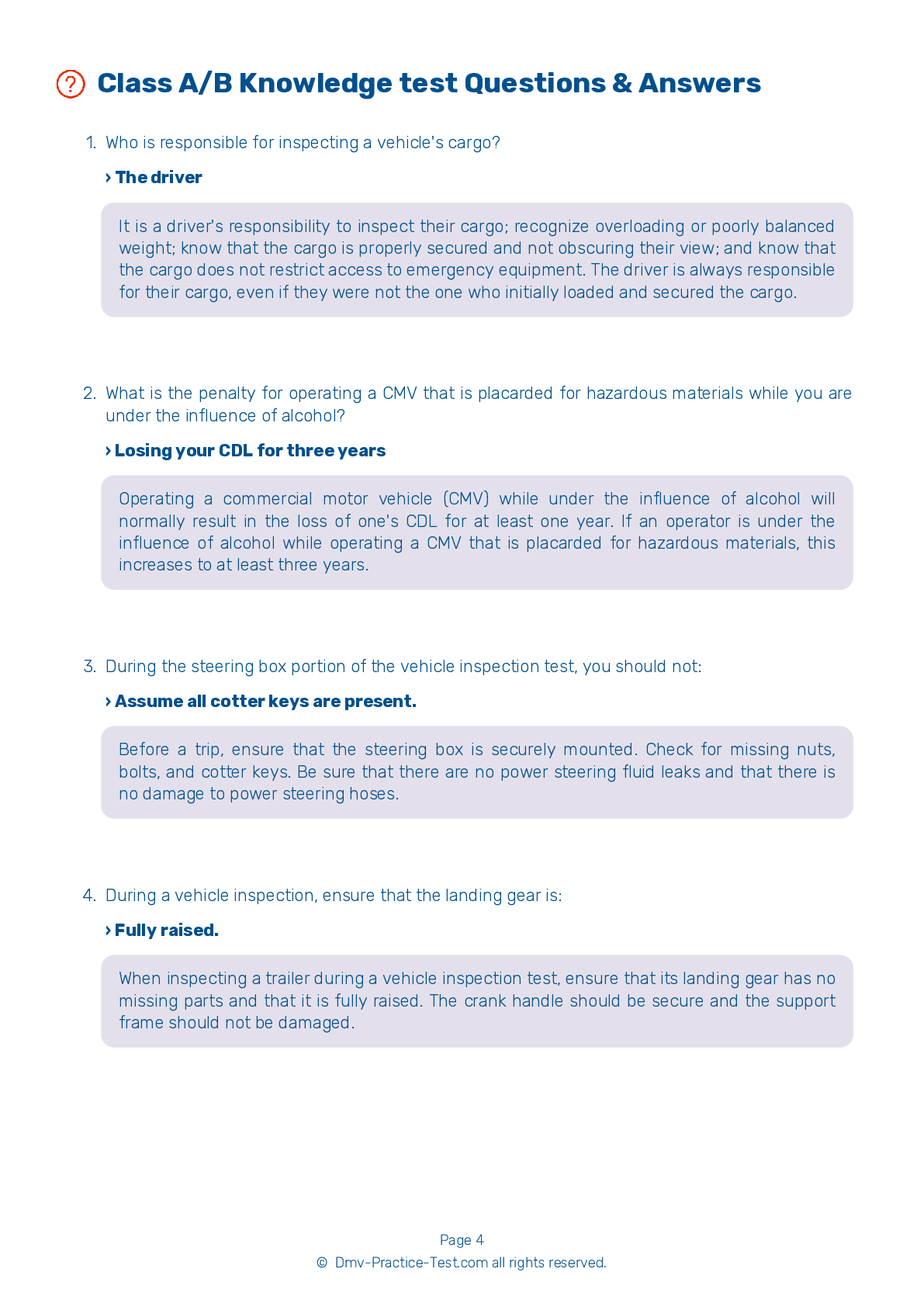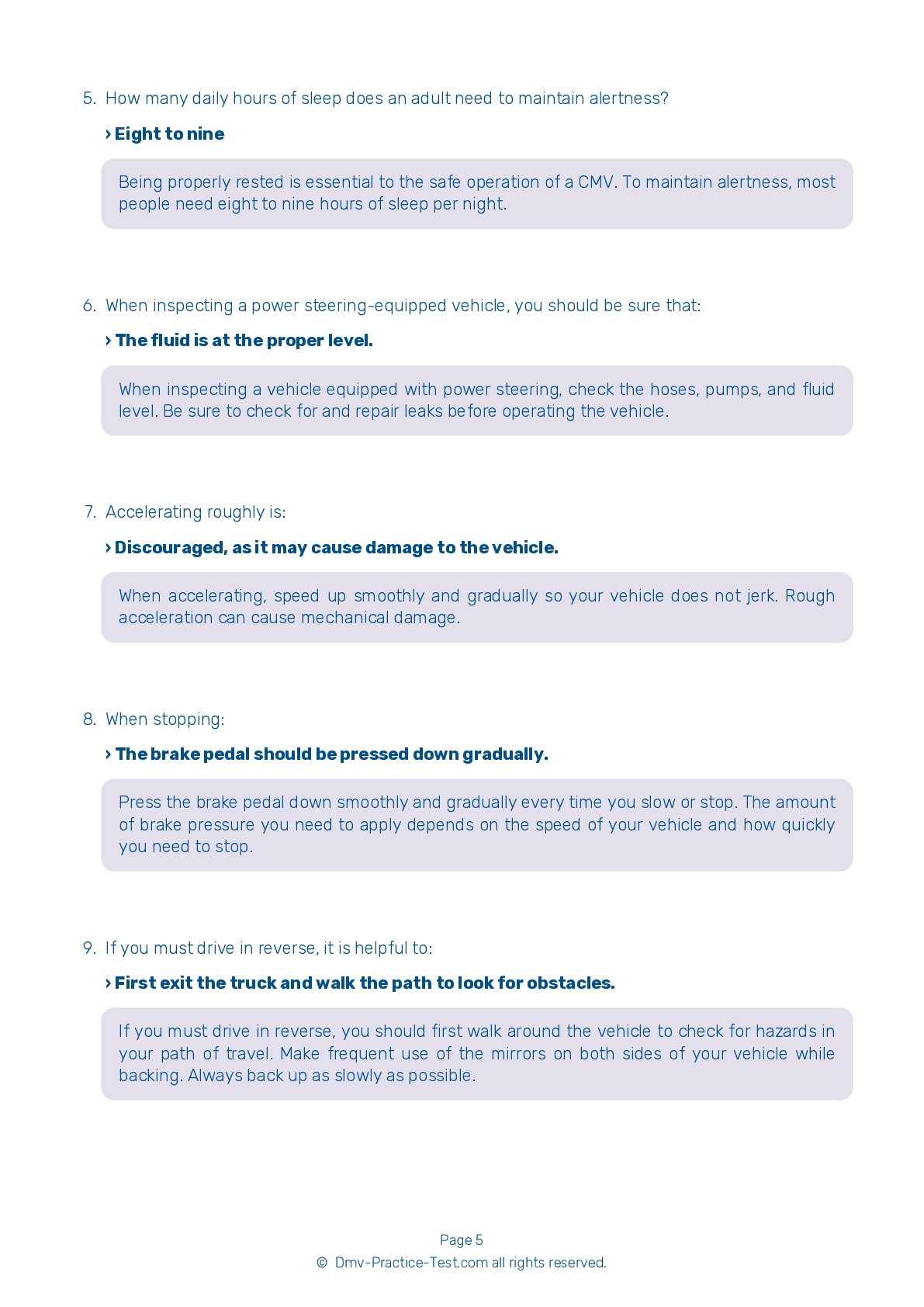Knowledge Test Class B #2
Class B Driving Test | Texas 2025 #2 Page 6 of 7
Train for FREE online with our Texas class B license test. The official exam test consists of several obligatory parts, with all of them checking your knowledge of different blocks of road rules. If you need to obtain a TX CDL class B permit in 2025, practice as much as possible. Free sample tests published on our website will help you check and improve your knowledge and boost your grades. Please bear in mind that CDL class B requirements may vary from state to state.
50
40
22
36 . When crossing railroad tracks, you should:
Stay in your lane.
When crossing railroad tracks during the on-road driving skills test, you must not stop, switch gears, pass another vehicle, or change lanes while any part of your vehicle is in the crossing.
37 . A low air pressure warning signal should activate:
When tank pressure falls below 5 psi.
In an air brake system, a low air pressure warning signal must come on if air pressure in the tanks falls below 55 psi. This warning signal may come in the form of a light, a buzzer, or a wig wag.
38 . When driving on the expressway during the skills test, you should:
Drive above the posted speed limit.
During the on-road driving skills test, you may be asked to drive on an expressway. Make sure you maintain proper lane positioning, vehicle spacing, and vehicle speed. Continue to thoroughly check traffic in all directions while on the expressway.
39 . When checking tire condition during the vehicle inspection, you should:
Ensure that the tires have even wear.
When examining your tires during the vehicle inspection test, you should ensure that treads are evenly worn.
40 . To inspect slack adjusters on S-cam brakes, you need to:
Chock the wheels and disengage the parking brake.
Check each slack adjuster after parking on level ground, setting wheel chocks, and disengaging the parking brake. Pull the slack adjusters to make sure they do not move more than about one inch from where the push rod is attached. If they move more than one inch, they may be out of adjustment and will need to be fixed.
41 . During the straight line backing exercise, how many times are you permitted to exit the vehicle to check its position?
Four times
During the straight line backing exercise, you are permitted to exit your vehicle to check its position no more than one time.
42 . On a truck with air brakes, the braking system’s air compressor:
Cleans the brakes.
In an air brake system, the air compressor pumps air into the air storage tanks. The air compressor is controlled by the air compressor governor.
2025 Texas | Frequently Asked Questions
To secure a CDL Doubles/Triples endorsement in Texas, you need to have a valid CDL license first. Then, study the Texas CDL handbook's section on Doubles/Triples endorsement. Afterwards, schedule an appointment at your local DMV to take the written test. Upon passing, you'll receive your endorsement. Remember, some employers may require additional on-the-job training.
To obtain a CDL Doubles/Triples license in Texas, you need to have a basic CDL license first. Then, pass the Doubles and Triples Endorsement Test which covers coupling and uncoupling, inspecting doubles and triples, and checking air brakes. Additionally, you must pass a vision test and provide proof of medical fitness.
While Texas doesn't require specific experience for a CDL Doubles/Triples endorsement, it's recommended to have practice handling such large vehicles. A CDL training course can provide this. You must pass a written test on handling double/triple trailers. Knowledge of coupling/uncoupling, inspecting trailers and air brakes is necessary. Professional training can greatly improve your chances of passing the test.
Yes, to obtain a CDL Doubles/Triples endorsement in Texas, you must pass an additional written test. This test covers information specific to driving double and triple trailers such as coupling and uncoupling, inspecting doubles and triples, and the proper procedures for pulling double/triple trailers. No additional road test is required for this endorsement.
The CDL Doubles/Triples endorsement test in Texas is a written exam, not a skills test. It focuses on knowledge such as how to couple and uncouple correctly, inspecting doubles and triples, and checking air brakes. You'll need to understand safe driving techniques for these larger vehicles, but you won't perform actual driving maneuvers during the test.
No, it's not permissible to operate double/triple trailers without a valid CDL Doubles/Triples endorsement in Texas. The endorsement is a legal requirement, demonstrating that the driver has the necessary knowledge and skills to handle such large vehicles safely. Driving without the appropriate endorsement could result in penalties, fines, or even loss of your CDL.
You can add the CDL Doubles/Triples endorsement to your current commercial driver's license. You don't need to initiate a new application for a CDL. However, you must pass the Doubles/Triples knowledge test. Once you pass, the Texas Department of Public Safety will add the endorsement to your existing CDL.
Yes, there are constraints for drivers with a CDL Doubles/Triples endorsement. For instance, these drivers must comply with specific weight and length regulations for their vehicles. They may also face restrictions related to hazardous materials transport. Additionally, they must adhere to hours-of-service rules set by the Federal Motor Carrier Safety Administration to ensure safe driving practices.
In Texas, the maximum legal weight for a semi-truck is 80,000 pounds without an overweight permit. The maximum length for a single trailer is 59 feet, while double trailers can be up to 28.5 feet each, and triple trailers up to 28 feet each. However, triple trailers are not legal on all roads in Texas.
Yes, there are specific safety guidelines for driving double/triple trailers. Drivers must ensure proper coupling and uncoupling of units, maintain safe following distance, and manage high-speed and curve control. They must also be aware of the "crack-the-whip" effect that can occur when changing lanes or turning. Furthermore, drivers must abide by Federal Motor Carrier Safety Administration regulations for hours-of-service.



